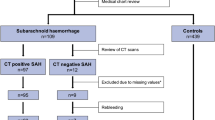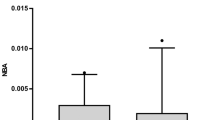Summary
The pathogenesis of posttraumatic subdural hygroma still remains largely unknown. One of the suggested pathological mechanisms is the traumatic development of an arachnoid tear and the subsequent efflux of CSF into the subdural space. We performed a multifactorial analysis of the hygroma fluid obtained at operation in comparison to the simultaneously taken plasma and lumbar CSF. The results of the protein analysis support the CSF origin of the subdural hygroma fluid.
Similar content being viewed by others
References
Cameron MM (1978) Chronic subdural haematoma: A review of 114 cases. J Neurol Neurosurg Psychiatry 41: 834–839
Cornell SH (1978) Diagnosis of extracerebral fluid collections by computed tomography. Am J Roentgenol 131: 107–110
Felgenhauer K (1974) Protein size and cerebrospinal fluid composition. Klin Wochenschr 52: 1158–1164
Felgenhauer K (1980) Protein filtration and secretion at human body fluid barriers. Pflügers Arch 384: 9–17
Felgenhauer K, Hanssen C, Remy A (1982) Laser-nephelometric evaluation of the humoral immune response in the central nervous system. Med Laboratory 11: 48–57
Felgenhauer K, Schädlich HJ, Nekic M (1987) ß-trace-protein as marker for cerebrospinal fluid fistula. Klin Wochenschr 65: 764–768
French BN, Cobb CA, Corkill G, Youmans JR (1978) Delayed evolution of posttraumatic subdural hygroma. Surg Neurol 9: 145–148
Hoff J, Bates E, Barnes B, Glickman M, Margolis T (1973) Traumatic subdural hygroma. J Trauma 13: 870–876
Jaccard E, de Tribolet N (1983) Les hygromes sous-duraux posttraumatiques. Neurochirurgie 29: 333–338
Koizumi H, Fukamachi A, Wakao T, Tasaki T, Nagaseki Y, Yamai Y (1981) Traumatic subdural hygromas in adults. Neurol Med Chir (Tokyo) 21: 397–406
Loew F (1982) Management of chronic subdural haematomas and hygromas. In: Advances and technical standards in neurosurgery, vol 9. Springer, Wien New York, pp 113–131
Masuzawa T, Kumagai M, Sato F (1984) Computed tomographic evolution of post-traumatic subdural hygroma in young adults. Neuroradiology 26: 245–248
Naffziger HC (1924) Subdural fluid accumulations following head injury. JAMA 82: 1751–1752
Oka H, Motomochi M, Suzuki Y, Ando K (1972) Subdural hygroma after head injury. Acta Neurochir (Wien) 26: 265–273
Olsson J-E, Link H, Nosslin B (1973) Metabolic studies on125J-labeled beta-trace protein, with special reference to synthesis within the central nervous system. J Neurochem 21: 1153–1159
Payr E (1916) Meningitis serosa traumatica bei und nach Schädelverletzungen. Med Klin 12: 841–846
Reiber H (1980) The discrimination between different blood CSF barrier dysfunctions and inflammatory reactions of the CNS by a recent evaluation graph for the protein of CSF. J Neurol 224: 89–99
Schurr PH (1969) Subdural hematomas and effusions in infancy. Develop Med Child Neurol 11: 108–111
Scotti G, Terbrugge K, Melancon D, Belanger (1977) Evaluation of the age of subdural hematomas by computerized tomography. J Neurosurg 47: 311–315
So St K, Ogawa T, Gerberg E, Sakimura I, Wright W (1976) Tracer accumulation in a subdural hygroma: Case report. J Nucl Med 17: 119–121
Stix P, Ladurner G, Flaschka G, Lechner H (1982) Die Relevanz psychiatrisch-neurologischer Symptome beim chronischen Subduralhämatom. Nervenarzt 53: 580–583
St John JN, Dila C (1981) Traumatic subdural hygroma in adults. Neurosurgery 9: 621–626
Stone JL, Lang RGR, Sugar O, Moody RA (1981) Traumatic subdural hygroma. Neurosurgery 8: 542–550
Todorow S, Happe M (1981) Das traumatische subdurale Hygrom. Neurochirurgica 24: 131–136
Weir B (1980) Oncotic pressure of subdural fluids. J Neurosurg 53: 512–515
Weir B, Gordon P (1983) Factors affecting coagulation: Fibrinolysis in chronic subdural fluid collections. J Neurosurg 58: 242–245
Weisner B (1980) Proteine aus Ventrikel- und lumbalem Liquor. In: Dommasch D, Mertens HG (eds) Cerebrospinalflüssigkeit CSF. Thieme, Stuttgart, pp 126–128
Wetterling T, Demierre B, Rama B, Spoerri O (1986) The clinical course of operated subdural hygroma. Acta Neurochir (Wien) 83: 125–130
Yamada H, Watanabe T, Sasaki T, Murata S (1980) Followup studies on 40 cases of posttraumatic subdural hygromas. Neurol Med Chir (Tokyo) 20: 1229–1238
Author information
Authors and Affiliations
Rights and permissions
About this article
Cite this article
Wetterling, T., Demierre, B., Rama, B. et al. Protein analysis of subdural hygroma fluid. Acta neurochir 91, 79–82 (1988). https://doi.org/10.1007/BF01400533
Issue Date:
DOI: https://doi.org/10.1007/BF01400533




